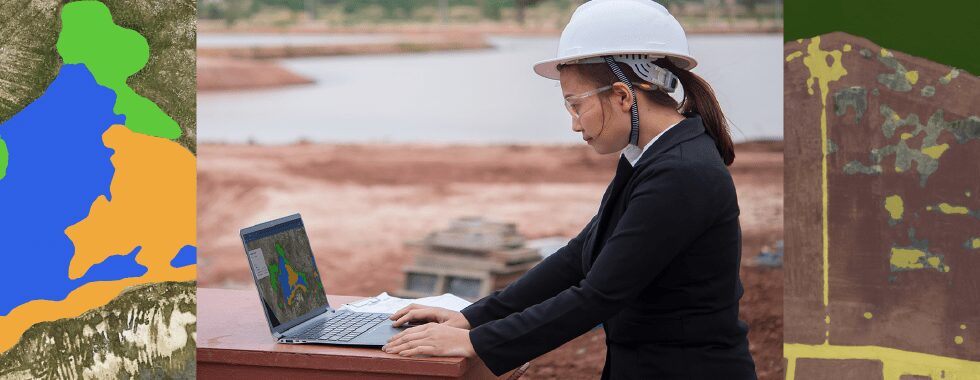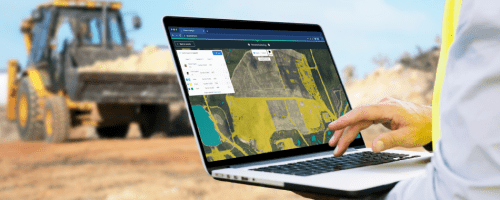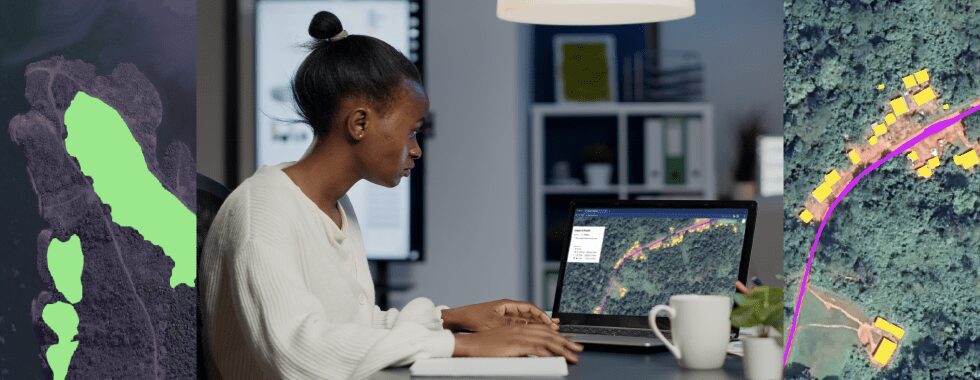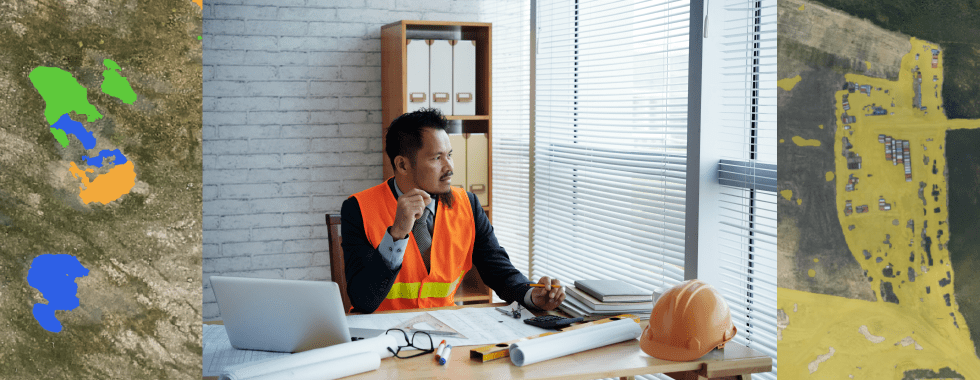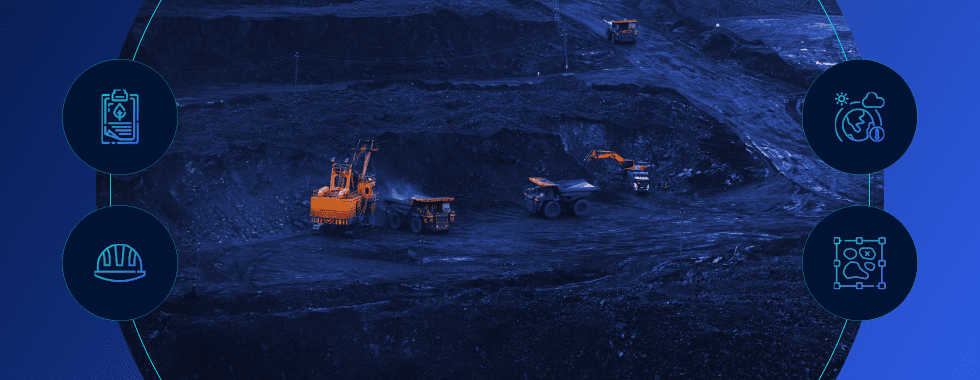Mining is an industry of great importance, significantly contributing to global economic development. However, it struggles with efficiency, safety, and sustainability challenges, which directly impact its economic viability and environmental footprint.
In the pursuit of solutions, AI and machine learning (ML) are emerging as transformative forces in the mining sector. They hold the potential to revolutionize mining efficiency and safety and foster sustainable mining practices. By integrating AI and ML with earth observation imagery analysis, we can generate valuable geospatial intelligence, enabling predictive maintenance and data-driven decision-making in mining.
This blog post aims to explore the necessity of AI in mining, examine its current applications, and discuss the challenges of adopting responsible AI in mining. We’ll delve into how AI and ML are revolutionizing mining efficiency, the future trends and possibilities in this arena, and the critical role of these technologies in fostering mining industry innovation and technological advancements. Stay with us as we navigate through the transformative potential of AI and ML in mining. This journey promises a future where mining is more efficient, safer, and truly sustainable.
Why AI in mining is needed
The mining industry is the backbone of the global economy, providing the raw materials that drive development and innovation. Yet, traditional mining practices often grapple with challenges that limit efficiency, safety, and sustainability. These include geological uncertainties, hazardous work environments, and high operational costs. Even as the demand for minerals and metals increases, these limitations have made it clear that innovative solutions are needed to propel the industry forward.
Enter artificial intelligence (AI) and machine learning (ML), technologies revolutionizing various sectors, including mining. Combined with geospatial intelligence, they provide an unparalleled opportunity to optimize mining operations. By leveraging AI and ML, mining companies can harness valuable insights from satellite and drone imagery, predict geological patterns, and make data-driven decisions that significantly enhance mining efficiency.
Want to learn more about how geoAI can be used in mining & quarries?
One example of AI’s transformative potential in mining involves using AI-driven geospatial analysis tools. These sophisticated systems can analyze satellite and drone imagery to identify mineral-rich zones, assess geological hazards, and monitor environmental impacts. By doing so, they expedite the exploration process and reduce the risk associated with drilling in areas with uncertain geological properties.
Moreover, AI and ML can also enhance safety in mining operations. For instance, by analyzing geospatial data, AI algorithms can identify potential geological hazards such as landslides or unstable terrains, enabling mining companies to take preventive measures and protect their workers.
AI and ML currently in mining
Data-driven decision-making in mining operations
In today’s mining landscape, operators are turning towards a data-driven decision-making process, seamlessly integrating sensor data, geospatial data, and other information sources. Advanced analytics form the backbone of this approach, with AI and ML algorithms sifting through massive datasets to provide valuable insights. For instance, sensor data from mining equipment can indicate performance patterns, while geospatial data can highlight areas of mineral richness or challenging topography. These insights become critical in optimizing mining strategies and resource allocation, a practice that leading global mining operations are starting to adopt.
AI-driven prospecting and exploration techniques
AI and ML are making significant strides in enhancing prospecting and exploration processes in the mining industry. With the help of geospatial intelligence, identifying potential mineral deposits has become more efficient and cost-effective. For instance, satellite imagery can be fed into ML algorithms to identify geological formations that typically host mineral deposits. By integrating these advanced technologies, mining companies can streamline their prospecting efforts, improving resource discovery and economic benefits.
Implementing AI-powered robotic systems for optimized mineral extraction
Robotic systems in mining are not a thing of the future—they’re happening now. The industry is witnessing a transformative phase, from autonomous drilling and excavation machines to AI-controlled transportation systems. Central to this transformation is geospatial data integration, which allows these autonomous systems to navigate complex mining terrains with pinpoint accuracy. As a result, mineral extraction is becoming more efficient, and logistics and material handling processes are being streamlined.
Proactive maintenance and increased productivity through AI-driven predictive maintenance
The future of maintenance in the mining industry is proactive, not reactive, thanks to AI. AI-driven predictive maintenance systems help minimize downtime and maximize uptime by predicting equipment failures. Such systems analyze data from various sources, including vibration, temperature, and pressure sensors, to forecast potential breakdowns. This predictive approach helps maintain high productivity levels and enhances equipment longevity by allowing for AI-optimized maintenance schedules.
Enhancing safety and risk mitigation through AI-powered monitoring and hazard prediction
Safety remains a top priority in mining operations, and AI is critical in enhancing it. Real-time worker safety monitoring is now possible with AI-enabled wearable devices that detect signs of fatigue, stress, or exposure to hazardous substances. Furthermore, geospatial intelligence plays a vital role in hazard identification and prevention. By analyzing geospatial data, AI systems can identify potential landslide zones or areas of toxic gas accumulation, enabling preventive measures. As a result, integrating AI in safety monitoring drastically improves risk mitigation in mining operations.
Overcoming challenges and adopting responsible AI in mining
Integrating AI, machine learning, and geospatial intelligence into mining operations offers transformative potential, but it also brings its own challenges. One of the key concerns revolves around data privacy and security. Mining operations generate vast amounts of data, and the processing and analyzing of this information require secure and robust data-handling procedures. It’s equally important to ensure the accuracy of AI models that make sense of this data, emphasizing the need for routine validation against real-world results.
In parallel, there is a pressing need to foster a culture of learning and upskilling within the industry. The successful adoption of AI and geospatial technologies hinges on a well-trained and adaptable workforce that can effectively harness these tools. By collaborating with experts in AI and geospatial technologies, mining companies can develop tailored training programs, educating their employees about these emerging technologies’ practical implications and applications.
Furthermore, attitudes toward AI and geospatial technologies are critical to their successful implementation. Encouraging an organizational culture that embraces technological advancement can help dispel apprehensions and promote wider adoption. By communicating the benefits of these technologies, such as their potential to enhance safety, improve efficiency, and increase productivity, mining companies can foster an environment that sees AI and geospatial technologies as a path to success rather than a threat to traditional methods.
Future trends and possibilities
As we look toward the future, several trends emerge in the mining industry’s convergence of AI, machine learning, and geospatial intelligence. These technologies pave the way for sustainable and responsible mining practices, transforming how we approach geological analysis, mineral prospecting, community engagement, and environmental impact assessment.
One of the most promising trends is AI-driven optimization of resource usage. Advanced AI algorithms can analyze vast amounts of data to provide insights on how to most effectively use resources, reduce waste and promote sustainability. For instance, predictive analytics can help estimate the optimal amount of water required for drilling processes, reducing excessive water usage and conserving this valuable resource.
The role of AI and geospatial intelligence in geological analysis and mineral prospecting is also expanding. As AI algorithms become more sophisticated, they can identify patterns and correlations in geospatial data that might be invisible to the human eye. This could lead to discovering new mineral deposits, increasing the efficiency and cost-effectiveness of exploration processes.
AI is also anticipated to play a significant role in fostering responsible mining practices and community engagement. Advanced AI models can help predict mining operations’ social and economic impacts on local communities, allowing for better planning and more proactive community engagement. This, coupled with AI-driven environmental impact assessments, can ensure mining operations align with sustainability goals and local regulations.
Moreover, integrating AI and geospatial intelligence can increase transparency and accountability in mining practices. AI-enabled traceability can track the journey of minerals from extraction to market, ensuring ethical sourcing and giving consumers confidence in the products they buy.
Finally, environmental impact assessments are poised to become more efficient and accurate using AI and geospatial data. Machine learning algorithms can process vast amounts of environmental data to predict potential impacts, enabling mining companies to mitigate adverse effects and comply with environmental regulations more effectively.
These emerging trends showcase the transformative potential of AI, machine learning, and geospatial intelligence in the mining industry. As these technologies evolve, they promise to make mining more sustainable, responsible, and efficient.
Conclusion
In the rapidly evolving landscape of the mining industry, AI, machine learning, and geospatial intelligence are playing an increasingly transformative role. From enabling data-driven decision-making and predictive maintenance to enhancing safety measures and optimizing resource allocation, these technologies are revolutionizing mining efficiency and productivity.
The potential of AI and geospatial intelligence extends beyond mere efficiency gains. They are critical in reshaping the future of mining towards a more responsible and prosperous industry. As we look ahead, AI is set to facilitate sustainable mining practices, provide deeper geological insights, enhance community engagement, and improve environmental impact assessments. On the other hand, geospatial intelligence is expected to improve mineral prospecting, risk mitigation, and operational logistics, among other applications.
As the convergence of AI, machine learning, and geospatial intelligence continues to bring transformative opportunities, mining companies must embrace these technologies. Adopting them leads to sustainable and efficient mining practices and contributes to a more responsible and prosperous industry.
So, let us heed the call of this technological revolution. Let’s strive towards harnessing the power of AI, machine learning, and geospatial intelligence to shape a future of mining that is sustainable, responsible, and prosperous. The future of mining is here, and it is digital.
